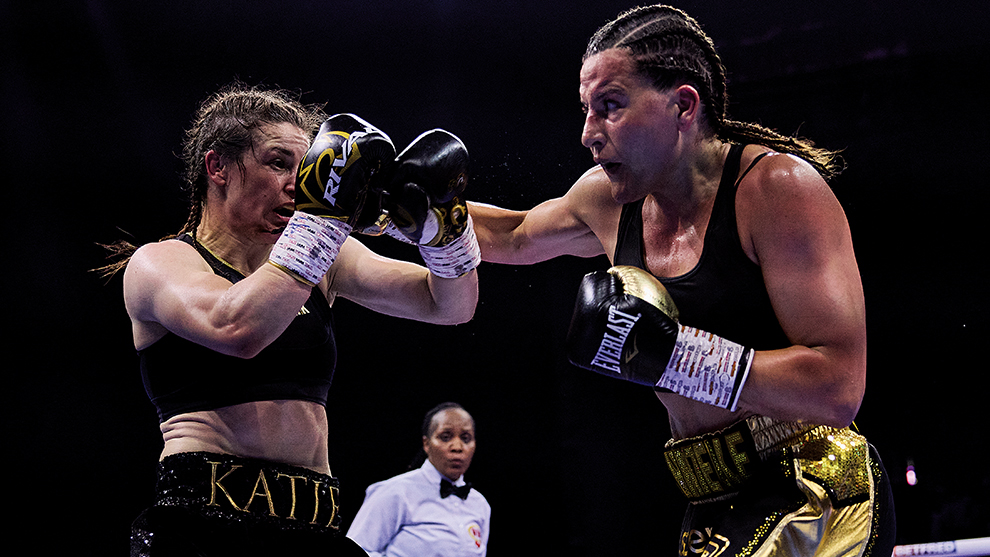IT’S COMPLETELY understandable why a group of female boxers are lobbying for their contests to be increased in duration. Currently, at professional level, their bouts are scheduled over four, six, eight or 10 rounds with those rounds lasting two minutes. It means that championship fights will be over 10-twos, which is a total of 20 minutes, some way below the men’s 12-threes (36 minutes).
Having spoken to several female boxers about this in recent years, one of the major reasons for wanting parity in ring time is strongly linked to a desire for parity in pay. The other common answers include more time being granted to implement game plans and for more stoppages – and thus excitement – to occur. Twenty minutes feels like a rush, some have told me, whereas over 36 minutes there is scope for some patience to be added to their skillsets and the time to grow and improve as boxers.
The reason why certain authorities are stalling on granting the fighters their wish has been brushed off as sexism by some. Certainly, the notion that ‘it just isn’t safe’ sounds somewhat contradictory when, very clearly, the men’s code isn’t safe either. No human body, whether born male or female, was designed to take punches.
However, as an open-minded advocate of female boxing, I would urge those in power to consider the implications of increasing the duration of contests. We have seen very few casualties in female boxing thus far. We have also witnessed an array of well-matched fights in which, I would argue, the 10-twos format heightened the excitement. Finally, and honestly, we have seen too many mismatches – even at the top level – where the thought of extending the duration of those bouts makes me wince.
Last week it was revealed that Hull’s Conor Coghill had been admitted to hospital with bleeding on the brain following his 12th round loss to Hopey Price on October 7. Going into that enticing clash with Price, Coghill was 14-0 and had only been 10 rounds once before. His other 13 contests were largely over four and six rounds against boxers with losing records. Every boxer aiming for the top will need to step up at some point but, as Price dropped Coghill in the sixth, 11th and twice in the 12th, it was clear that it was just too steep.
That’s not to blame the 12-threes format for Coghill’s injury but more a reminder of the potential consequences of long, hard fights. A reminder, also, that boxers – the bravest and most foolhardy of all athletes – are surely not the ones who should be deciding how long they fight for. If one were to take a similar poll of male boxers it’s likely they’d like a return to the 15-round format and, while they’re at it, tell the referees to be more lenient and just let them fight.
Amanda Serrano has been vocal about her desire to fight 12 three-minute rounds (Sam Hodde/Getty Images)
That’s not to say the discussion is not a worthwhile one. The development of women’s boxing in recent years has been a joy to witness. One wonders, however, if increasing both the amount and duration of rounds is a step too far – 10-threes or 12-twos might be a more sensible experiment – for a sport in which only a small percentage are of true championship quality.
To suggest that it’s any different in the men’s code might be a little rich given what we witnessed, or chose to avoid like the plague, at the weekend. If we’re to learn one thing from Tommy Fury’s latest battle with an influencer it’s that records can be extremely misleading. For his second consecutive outing against someone who only learned to box comparatively recently, Fury struggled to convince. In fact, during his 10-bout career, his two trickiest assignments came against Jake Paul and KSI.
Though I simply cannot stand the invasion of influencers into boxing, it’s worth pointing out that prior to fighting two of them, Fury was 8-0 (4) against licensed boxers and had not come close to losing a single round. That KSI and Paul gave him much more taxing affairs should provide food for thought when debating the merits of prospects versus journeymen-type affairs. Like it or not, KSI and Paul were clearly a step up from the professional boxers Fury had before been facing.
Crucially – and thankfully – none of them are anywhere near close to elite level. That they’re being paid so handsomely is another story, but it highlights one last simple economics lesson for the sport to learn: Fighters earn what they’re perceived to be worth. It’s not about the duration of the fight, gender or titles on the line, it’s about giving those who are willing to pay what they want.
